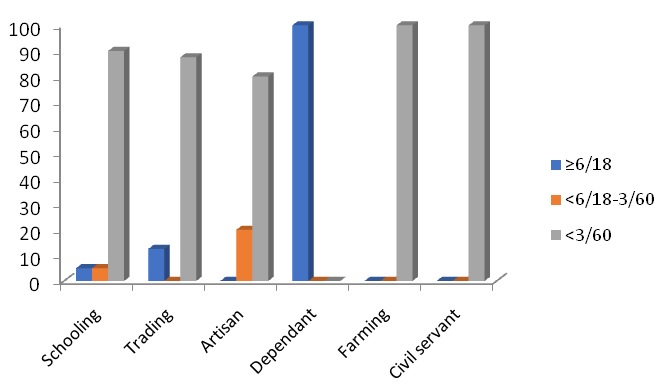Visual Outcome of Corneal Laceration Repair in a Tertiary Hospital, Southwestern, Nigeria
Abstract
Objective: This study aimed at assessing the visual outcome of patients that had corneal laceration repair with their influencing factors in order to reduce the significant consequential vision loss in the patients.
Design: A cross sectional study.
Subjects: All patients who had open globe injury and corneal repair procedures.
Methods: Clinic and theatre records of all patients who had open globe injury and corneal repair procedures between January 2015 and July 2017 were retrieved. Demographic characteristics, main eye complaints, duration of symptoms, laterality, presenting visual acuity, corneal repair procedures and six weeks post operative visual acuity were obtained from the records. All patients who had open globe injury but had primary Enucleation or Evisceration were excluded from the study. Data obtained were recorded and analyzed using Statistical Package for Social Sciences (SPSS) version 25.
Results: Forty patients had corneal repair procedure constituting 22.2% of all ophthalmic procedures. There were 30(75.0%) males and 10(25.0%) females. At the oculoplastic clinic, majority of the patients 33(82.5%) presented with monocular blindness (VA<3/60) while, only the dependent group of patients 5 (12.5%) presented with normal visual acuity ≥6/18. There was 10% improvement in vision after corneal repair procedure. There was positive correlation between pre-operative visual acuity and post-operative visual acuity.
Conclusion: Corneal laceration injury has a relatively high incidence with a 10% improvement in vision after corneal repair procedure. Timely presentation, prompt clinical assessment and early intervention when non-avoidable ocular injury occurs remain the key to a good functional post-operative vision.
Downloads
References
2. Rahman I1, Maino A, Devadason D, et al. Open globe injuries: factors predictive of poor outcome. Eye (Lond). 2006 Dec;20(12):1336-41. Epub 2005 Sep 23.[pubmed]
3. Gilbert C, Soong H, Hirst L. A two-year prospective study of penetrating ocular trauma at the Wilmer Ophthalmological Institute. Annals of ophthalmology. 1987;19(3):104-6.
4. Kim J, Marbella A, Knippers J. Incidence of Open Globe Injuries in Wisconsin for 2002. Investigative Ophthalmology & Visual Science. 2006;47(13):3959-.
5. Adeoye A, Olateju S, Soetan E. Communal conflict-related ocular trauma. Nigerian Journal of Clinical Practice. 2002;5(1):1-4.
6. Sternberg Jr P. Prognosis and outcomes for penetrating ocular trauma. Eye Trauma St Louis: Mosby Year Book. 1991:238-41.
7. Hooi SH, Hooi ST. Open-globe injuries: the experience at Hospital Sultanah Aminah, Johor Bahru. Med J Malaysia. 2003 Aug;58(3):405-12.[pubmed]
8. Groessl S, Nanda SK, Mieler WF. Assault-related penetrating ocular injury. Am J Ophthalmol. 1993 Jul 15;116(1):26-33.[pubmed]
9. Odugbo O, Mpyet C, Wade P, Adenuga O, Adejoh M. An audit of minor ophthalmic surgical interventions in a tertiary eye care facility in Northern Nigeria. Journal of the West African College of Surgeons. 2014;4(2):26.
10. Eze BI. Audit of ophthalmic surgical interventions in a resource-deficient tertiary eye care facility in Sub-Saharan Africa. J Health Care Poor Underserved. 2013 Feb;24(1):197-205. doi: 10.1353/hpu.2013.0013.[pubmed]
11. Khatry SK, Lewis AE, Schein OD, et al. The epidemiology of ocular trauma in rural Nepal. Br J Ophthalmol. 2004 Apr;88(4):456-60.[pubmed]
12. Sobaci G, Mutlu FM, Bayer A, et al. Deadly weapon-related open-globe injuries: outcome assessment by the ocular trauma classification system. Am J Ophthalmol. 2000 Jan;129(1):47-53.[pubmed]
13. Omolase CO, Omolade EO, Ogunleye OT, et al. Pattern of ocular injuries in owo, Nigeria. J Ophthalmic Vis Res. 2011 Apr;6(2):114-8.[pubmed]
14. Jahangir T, Butt NH, Hamza U, Tayyab H, Jahangir S. Pattern of presentation and factors leading to ocular trauma. Pak J Ophthalmol. 2011;27(2):96-102.
15. Okoye O, Maduka-Okafor F, Eze B. Open globe injuries. Nigerian Journal of Surgical Sciences. 2007;17(1):37-42.
16. Ajayi IA, Ajite KO, Omotoye OJ. Epidemiological survey of traumatic eye injury in a Southwestern Nigeria tertiary hospital. Pakistan Journal of Ophthalmology. 2014;30(3):138.
17. Smith D, Wrenn K, Stack LB. The epidemiology and diagnosis of penetrating eye injuries. Acad Emerg Med. 2002 Mar;9(3):209-13.[pubmed]
18. Agrawal R, Rao G, Naigaonkar R, et al. Prognostic factors for vision outcome after surgical repair of open globe injuries. Indian J Ophthalmol. 2011 Nov-Dec;59(6):465-70. doi: 10.4103/0301-4738.86314.
19. Cillino S, Casuccio A, Di Pace F, et al. A five-year retrospective study of the epidemiological characteristics and visual outcomes of patients hospitalized for ocular trauma in a Mediterranean area. BMC Ophthalmol. 2008 Apr 22;8:6. doi: 10.1186/1471-2415-8-6.
20. Kuhn F, Morris R, Witherspoon CD, et al. A standardized classification of ocular trauma. Graefes Arch Clin Exp Ophthalmol. 1996 Jun;234(6):399-403.[pubmed]
21. Adeoye AO, Onakpoya OH. Indication for eye removal in Ile-Ife, Nigeria. Afr J Med Med Sci. 2007 Dec;36(4):371-5.[pubmed]
22. Joseph OO, Adeseye AI, Oluseye AO. Patients’ Satisfaction with Destructive Eye Surgery in Ophthalmic Plastic Clinic in a Tertiary Institution.

Copyright (c) 2019 Author (s). Published by Siddharth Health Research and Social Welfare Society

This work is licensed under a Creative Commons Attribution 4.0 International License.


 OAI - Open Archives Initiative
OAI - Open Archives Initiative



















 Therapoid
Therapoid

